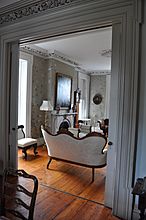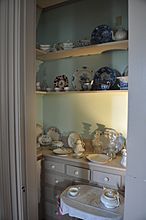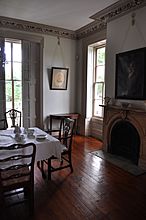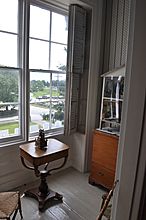Capt. Nathaniel B. Palmer House facts for kids
|
Captain Nathaniel B. Palmer House
|
|
 |
|
| Location | 40 Palmer Street, Stonington, Connecticut |
|---|---|
| Built | 1852 |
| Architect | Collins & Sons |
| Architectural style | Italianate |
| NRHP reference No. | 96000971 |
Quick facts for kids Significant dates |
|
| Added to NRHP | June 19, 1996 |
| Designated NHL | June 19, 1996 |
The Captain Nathaniel B. Palmer House is a cool old house in Stonington, Connecticut. It was built between 1852 and 1854. The house mixes two popular building styles from that time: Greek Revival and Victorian Italianate. This house was built for Nathaniel Brown Palmer (1799–1877). He was an amazing adventurer! He hunted seals, explored Antarctica, and designed super-fast ships called clipper ships.
In 1995, the house was almost torn down. Luckily, the Stonington Historical Society saved it. Today, they run it as a museum. You can learn all about Captain Palmer there. The house became a National Historic Landmark in 1996. This means it's a very important historical place in the United States.
Contents
Exploring the Palmer House
The Palmer House sits on a piece of land in Stonington Borough. It's between Quanaduck Cove and Lamberts Cove. The house is on a 4-acre (1.6 ha) plot of land. This is all that's left of the large property the Palmer family once owned.
What the House Looks Like
The house is made of wood and is shaped like a square. It has three sections across the front. It is also two and a half stories tall. There's a kitchen section that sticks out from the back. The roof is flat on top with slopes on the sides. It also has a pointed section in the middle of each side.
Right in the center of the roof is an eight-sided tower. This tower has windows all around. From up there, you can see everything in every direction! The main front door has a flat roof over it. This roof is held up by fancy columns. These columns have special grooves and get thinner at the top. There are also flat, decorative columns on either side of the double front door.
The windows on the front of the house have decorative frames. These frames have fancy carved pieces. The edges of the main roof, the front door's roof, and the tower all have decorative tooth-like carvings and brackets.
Inside the House
When you go inside, you'll find a main hallway in the middle. There are four rooms on each side of this hallway on every floor. The main rooms have beautiful plasterwork and wooden decorations. They also have fancy marble details.
One special room is Captain Palmer's study on the ground floor. It has built-in cabinets. These cabinets have shelves perfect for nautical charts. The doors are made of mahogany wood.
Captain Nathaniel Palmer's Amazing Life
The Palmer House was built for Nathaniel Palmer and his brother Alexander in 1852. Captain Palmer lived there until he passed away in 1877. He didn't have any children. So, he left the house to his niece and her husband. The house stayed in their family until 1976.
A Young Sailor's Start
Nathaniel Palmer grew up in a family of sailors. He went on his first sea trip when he was just 14 years old! Stonington was a big center for hunting seals back then. Palmer joined the seal hunting trade in 1819.
Discovering Antarctica
The next year, in 1820, he became the captain of a small ship. This ship was called a sloop. It was about half the size of Christopher Columbus' ship, the Niña. Palmer's sloop was used to scout ahead for a fleet of seven larger seal-hunting ships.
During a long ocean journey, Palmer saw the Antarctic Peninsula on November 17, 1820. This area is now sometimes called Palmer Land. To remember his important role in this discovery, there's an American research station named Palmer Station in Antarctica.
Designing Super-Fast Ships
Later in his life, Captain Palmer started designing ships. He wanted to make them faster. In 1843, while on a trading trip to China, he designed a new type of ship. It was a very early version of a clipper ship.
The next year, a ship called the Houqua was built based on his design. This ship made a record-breaking trip! It sailed from New York City to Canton, China in just 95 days. That was incredibly fast for the time!
Gallery
See also









